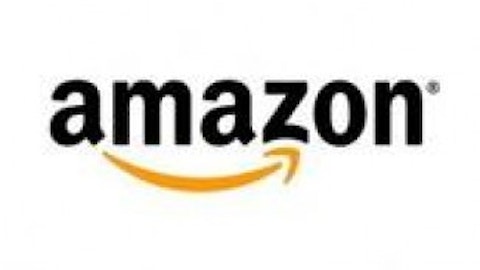Amazon.com, Inc. (NASDAQ:AMZN) has not grown in percentages, but in multiples in the last few years. The company has seen its revenue rising exponentially, riding on the wave of a low price sales boom. By keeping margins razor thin, it has ensured continuous gains in market share while major competitors like Target Corporation (NYSE:TGT) and Best Buy Co., Inc. (NYSE:BBY) are struggling to keep up with the mounting pressure on profit margins.
The stock has not been an exception to the growth story and has grown by over 200% during the last five years and more than 500% when compared with the low of the 2008 recession. The company is optimistic about the future, and so are investors. Quarter after quarter, more and more investment has poured in, showing the belief in the business model which focuses more on creating a highly profitable organization for the future rather than focusing on current margins. Indeed, the operating margins have been shrinking over the years, as can be seen from the following chart.

In my opinion, he is only partially correct in this regard. The company has indeed spent billions of dollars in building the so-called fulfillment centers throughout the US, which have the capacity to cater to very high demand, which is forecast in the near future. Also the company has heavily invested in technologies such as the cloud and development of next generation computing devices. These investments are bound to pay off in the future and with high probability will lead to very high cash flow.
But the story does not end here. A major chunk of the profit is eaten away by the free delivery service it offers to its customers. It is literally spending billions of dollars on free delivery which could otherwise have been passed on to the customers, maybe even partially. There is also skepticism over whether the company can continue to grow earnings. Given these situations, it becomes hard to look at the stock as an attractive option to invest when it is already trading with a PE ratio of 3,840, making it an extremely costly investment.
There are other factors as well. The company only operates in seven countries. If it wants to expand its reach to big developing markets such as India and China, it can only do so by creating the complete infrastructure required to deliver products with the same efficiency as it does in the home market. This has a big cost associated with it and is the main reason behind the company’s low international presence. This issue makes it very likely that Amazon will miss the bus of exponential business growth offered by developing countries.
So why is it that even with so many obstacles and a business model that appears to many a recipe for disaster, the stock has continued to grow? To understand this, we need to dig deeper and understand the company philosophy. It is based on faith, faith that some day in the future it will turn more profitable and will finally start to yield to its investors. But in my opinion, this sentiment is not going to last for long, and if the company does not deliver more profit to shareholders soon, the current valuation levels will not last.
Let’s examine the cash flow data in hand to see how exactly the company is able to generate heavy cash even with practically no profit. The high cash flow can be attributed to two factors. First is the fact that the company has longer terms of payment with its suppliers (generally more than 90 days). Secondly, it ensures that it gets payment from sales in a shorter duration (normally less than 30 days). This means that for approximately 60 days it is sitting on a cash pile without having to pay anyone. With a short duration inventory clearing cycle, this translates into huge continuous cash inflow for the entire year. This means that there are many items in the cash flow statements such as unearned revenue, accrued expenses etc. that help inflate the cash flow values and should be carefully taken into consideration while making an investment decision.
Lastly, the tablet business has not been able to compete with majors such as Apple Inc. (NASDAQ:AAPL). Among other reasons, one which has hurt the most is Amazon’s inability to sell the product through mega retail chains such as Wal-Mart Stores, Inc. (NYSE:WMT) and Target, as they are Amazon’s competitors in retail business. Also, the tablets are sold at near cost price in the hope that profits will come from sales of e-books and movies through the Kindle store. Until now the scenario looks very bleak as the balance sheet does not show any profit from this business.
The competitors are not far behind either. Best Buy recently announced that it will keep prices at Amazon’s level throughout the year. Even though its sales fell by 4.3% in last quarter, it is continuously improving its business model to compete better. Target, another competitor, has also adopted the same strategy as Best Buy, which may help the company retain its current market share. But the critical point is that they will face extreme difficulty in keeping prices low for a long duration due to higher supply costs.
Going ahead, it will be interesting to see how the company fares in subsequent months. If there are signs of increasing profit, the current prices might not be a fair valuation and we can expect it to move even higher.
The article Amazon: A Future Based on Faith originally appeared on Fool.com and is written by Sujata Dutta.
Copyright © 1995 – 2013 The Motley Fool, LLC. All rights reserved. The Motley Fool has a disclosure policy.




